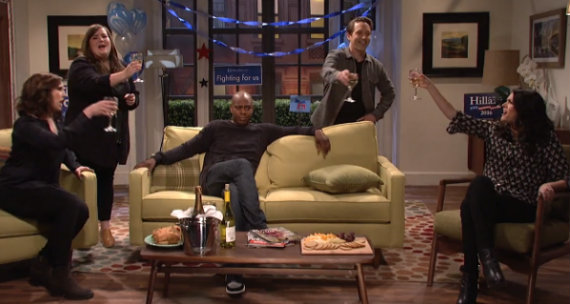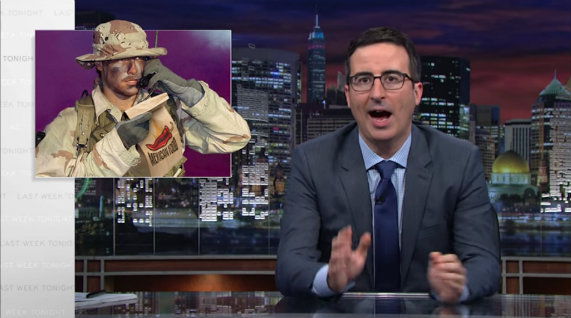Injecting Humor Into Discussions of the News
A MiddleWeb Blog
 Discussing political news these days continues to feel like walking on glass barefoot, and so I find myself even more drawn toward humorous interpretations of current events.
Discussing political news these days continues to feel like walking on glass barefoot, and so I find myself even more drawn toward humorous interpretations of current events.
And, with the plethora of satirical political late-night shows out there, it is often tempting to pull a clip into class to get some easy laughs, especially at the end of a week full of serious news. However, I’ve found it’s equally easy to get burned if I’m not careful.
Election Humor Gone Wrong
One clip I would not show again came just after the presidential election in November. Everyone’s nerves were raw.
Many students were asking me to show Saturday Night Live’s “Election Night” skit, which I had watched once on my own at home. I thought it would make liberal students feel better because it showed that few Democrats had predicted the results of the election. I thought it would lift the moods of conservative students because it poked fun at liberals’ complacent certainty that Hillary Clinton would win.
However, as the video unspooled in real time during the end of my first-period class, projected large on the white board, I realized that it simplified ideas too much in the name of humor.
The skit’s discussion about racism was not complex enough to help my students understand the nuances of why people voted for Hillary Clinton or Donald Trump. I found myself in the uncomfortable position of having to explain that the clip was making fun of liberals as much as conservatives – but even that explanation didn’t soften the intensity of some of the video’s comments.
Of course, Saturday Night Live is extremely liberal, and as a result I am careful when bringing even three minutes of its sketches into class. Yet, in its moments when it “roasts” (one of my students’ favorite words) fellow liberals, it can be brilliant and on point for classroom discussion.
One sketch that did work after the election made fun of liberals without blasting conservatives along the way. The show’s “Liberal Bubble” skit sent up the tendency of coastal liberal elites, such as those in Brooklyn, to live in a world of their own creation, complete with raw milk and multimillion-dollar real estate prices.
In class, the video prompted a discussion not only of how unhappy liberals were at the results of the election but also how different parts of the country have come to think so differently about politics.
Screening for Good-Natured Humor
So what works more generally in screening for appropriate humorous videos?
When Jon Stewart was host, The Daily Show functioned as potential gold mine of comedic classroom clips. Although Stewart of course leaned liberal, as do most comedic talk-show hosts, he sometimes functioned as a witty voice of reason for both sides.
This attempt at balance also appeared after the 2016 election, when Stewart (commenting on CBS) advised fellow Democrats to see the election results through a lens of bipartisanship. Although he is not comedic here, he is insightful and able to gain the attention of students who have grown up laughing at his work.
In contrast, certain shows are almost never appropriate for younger adolescents because of consistently foul language or overly adult content.
For instance, John Oliver’s Last Week Tonight can be hilarious and pointed in its skewering of government bureaucracy, such as when he described the dilapidated conditions of some of the United States’ nuclear facilities a couple of years ago. However, all too often when I’ve screened Oliver’s HBO clips, I stop a few minutes in because he throws in too many swear words or gratuitous references.
Trevor Noah on The Daily Show gives monologues similarly studded with comments I would not want middle schoolers to hear in the classroom.
Not Your Parents’ Schoolhouse Rock
Beyond the classic Schoolhouse Rock, certain more recent shows are also helpful for understanding government. A clip that a number of students have recommended over the past several years is Adam Ruins Everything’s “Why the Electoral College Ruins Democracy.”
In a highly visual and irreverent way, the 5-minute video explains how population gives states (sometimes unequal) representation in the college – offering a taste of politics that, in the past, has piqued students’ interest enough to learn more about the system.
Where do I find most of these videos? Usually from my students, which I’m grateful for because they are far more current and quick than I am in picking out digital content across platforms.
After I show one or two videos in class during the first month or two, students will either email me clips for consideration or tell me about them as we start class. But I always make sure to screen clips before showing them.
The Bottom Line: My 4-Question Test
Ultimately, I ask myself four questions when thinking about using a humorous clip in the classroom:
- Have I screened the entire video?
- Is this video nonpartisan enough that I would be comfortable showing it not only to my students but to their parents?
- Does this video have an enduring message that I can refer back to, such as the old-fashioned nature of the electoral college or the anonymity of airstrikes versus a ground war?
- Does this video have some kindness in it, even toward the people it skewers?
If the answer is yes on all four, then I will show it. Otherwise I usually move on, confident that in a world full of memes, more video choices are right around the corner.


































Sarah, I wish all teachers could read your article. The fact that students recommend most of the videos is terrific–it was the first time I watched an “Adam Ruins Everything” video. Your four-question test is superb, especially question 4.
Thanks so much, Mary! As always, it is refreshing to hear what students find and think.
I’m sharing this on Twitter and my Facebook page.